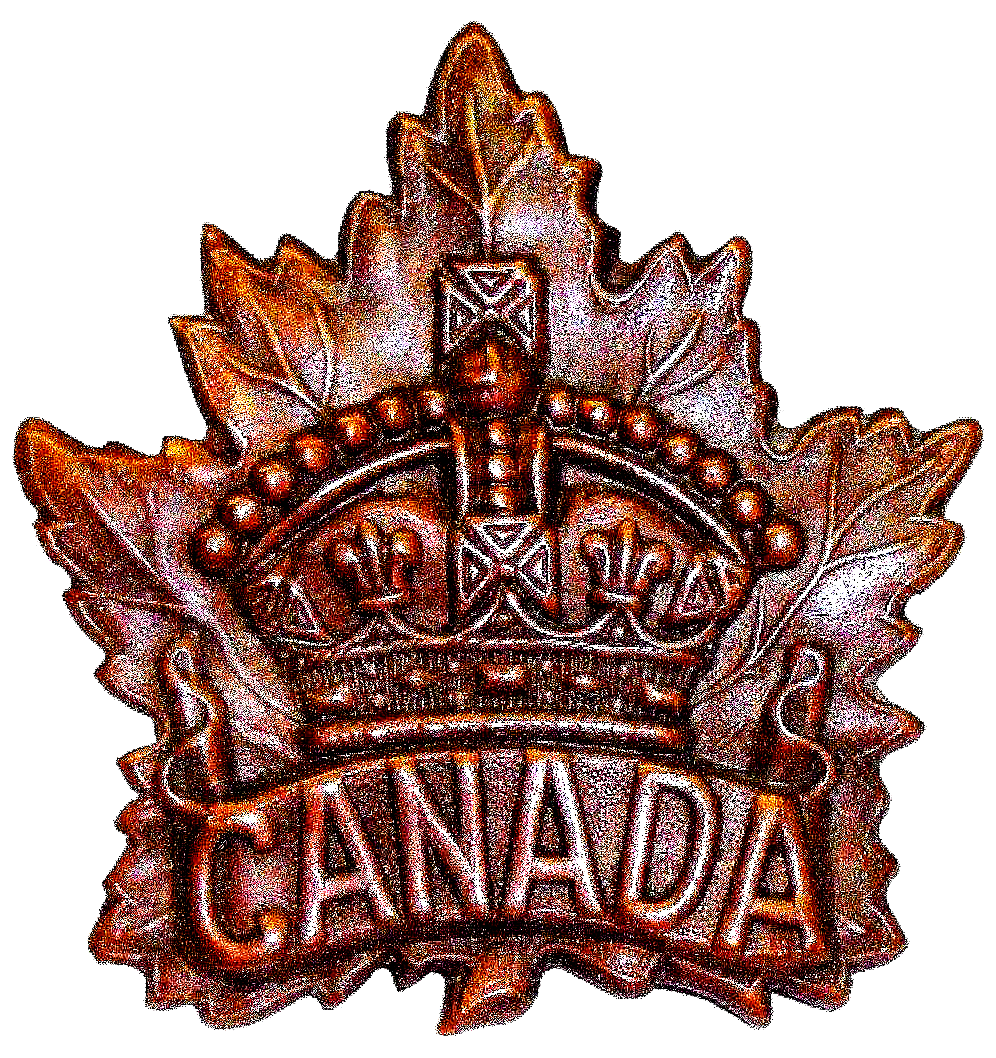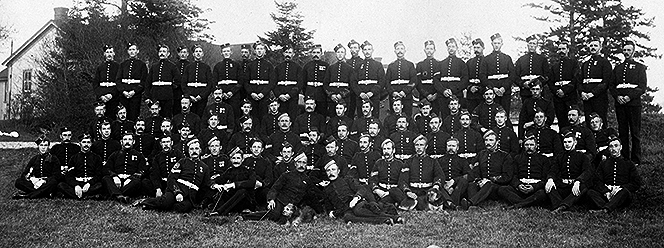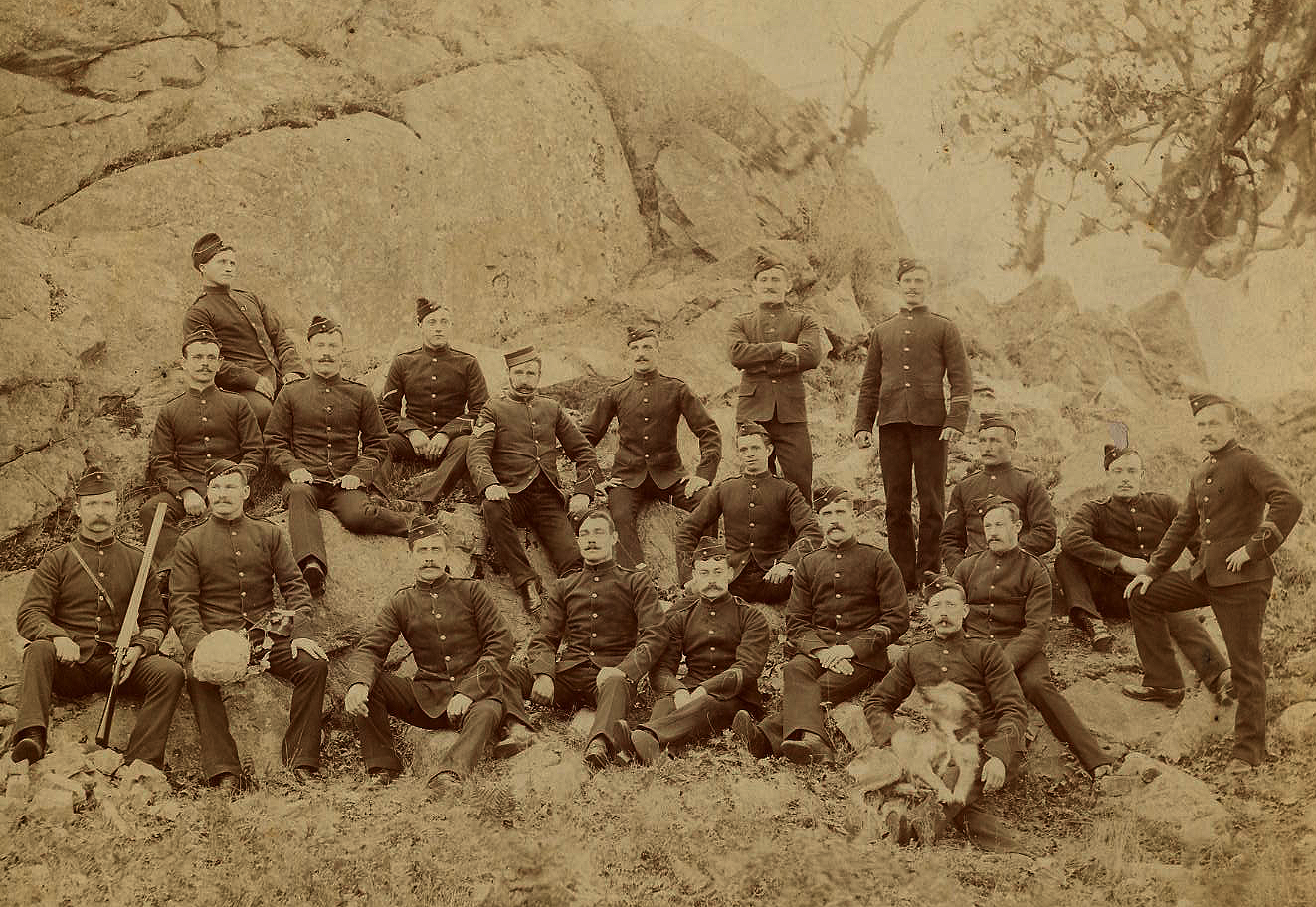 |
 OPCMHVisitor No.: |
HISTORY OF WORK POINT BARRACKSby Jack BatesPART 3 — 1894 to 19061894Militia and Defence February 5, 1894 To: Deputy Minister of Militia and Defence Sir: In reply to your letter dated the 12th ultimo, asking to be informed when the new Powder magazine at Victoria, B.C. will be ready for occupation, I am directed to state that Mr. Gamble reports that, on the 15th of December, last, the Powder magazine was handed over to the Imperial Authorities as forming part of the barracks lately occupied by “C” Battery. I have the honour to be, Sir Daily Colonist MARINES FOR ESQUIMALT Arrival of a Detachment at Montreal — Hearty Reception Montreal, March 22 – The Royal Marines artillerymen en route from Plymouth to Esquimalt, B.C. have arrived here. The party is in charge of Major Rawston and numbers 56. At 10:30 a.m. Col. Stevenson was present to set as host and guide of the artillerymen, who were in heavy marching order. They marched up Notre Dame street, Major Rawston at their head, and beside him Col. Stevenson and Mr. Lambkin, passenger agent of the C.P.R. at Quebec, who has charge of the party as far as North Bay. The line of march was along Notre Dame street to Place d’Armes square, then to St. James street and Victoria square. As they passed the statue of Her Majesty they brought their rifles to the shoulder. They then proceeded up Beaver Hall hill, west on Dorchester street to Dominion square, down Windsor street to the C.P.R. station. The party was drawn up along Osbourne street in front of the station, while Major Rawston went up to Mr. McNicoll’s office to arrange transportation details. When the officer had concluded his business he and Col. Stevenson led the men down Windsor street, along St. Antoine and down Inspector street to Chaboilles square, and then into the fire station, and here the artillerymen saw a little exhibition of what firemen can do. The marines almost filled the station. Some were drawn up in front just inside the doors, others were placed on the stairs, and the remainder were placed in the salvage wagon and on the reels. Col. Stevenson explained that an alarm would be rung and the horses hitched ready to start for a fire. This was done to the satisfaction of every spectator, and the artillerymen showed their approval by thumping the floor with their rifles. The firemen came down the brass poles just as they do when in a hurry, and several of the artillerymen did the same. Col. Stevenson showed Mrs. Rawston, who had accompanied her husband, about the station and the fire apparatus was examined with interest and evident approval. The visitors then marched back t the drill hall, where they spent a few minutes looking over the headquarters of the militia. From thence they went down to the Dalhousie square station, where dinner was awaiting them on the cars. At 4:30 p.m. they left for the west on the Winnipeg train. F.D.H. Nelson — March 29. — RMA, main party, marched to Work Point, 55 all ranks, 17 women and 26 children to Work Point; housed in 10 married quarters at Esquimalt and house in town. Victoria Times THE FORTIFICATIONS To the editor it seems more than probable that Chinese will be employed on the fortifications at Esquimalt, despite the fact that hundreds of our own people are in need of work. Chinese labor, or Chinese pay, will keep the white workingman from earning a decent living. The Canadian Pacific railway on this coast was constructed by Chinamen. All government work appears to benefit but one class, the Chinese. A white man applied for work on the fortifications and was informed that the pay will be one dollar and twenty five cents per day, without board. All white skilled labor will be imported from England with tools and implements. Only Chinese can live on the daily wage, which is twenty five cents above the sum paid to save the unemployed of San Francisco from starvation during the winter months. I am an Englishman, Mr. Editor, and am proud of my country; if the Chinese are a more favored nation, let my flag wave over Chinatown, Then my advice to our native sons will be, “Get out of a country where you compete with the cheapest labor on earth.” In a civilized country we decline to be brought down to the level of slaves, and prefer death to degradation. We must live, and our working classes are crying for bread. The government has a chance to assist our fellow countrymen, and if living wages obtain, thousands of white men will be at work with the pick and shovel on the fortifications at Esquimalt. LABOR SECOND DETACHMENT HERE Royal Marine Artillerymen Arrive to Assist in Fortifications A detachment of Royal Marine Artillery numbering 56 men under the command of Major Rawstorne arrived in the city from England on the steamer Premier at 2 o’clock this morning. Yesterday’s train was late and the boat did not leave Vancouver until 7:15 last evening. Two of the tramway company’s trailers were in waiting on Government street for the soldiers and conveyed them to the Work point barracks where they are to be quartered with the rest of the men of the same corps who reached here several months ago. The men are described as fine a set of soldiers as ever wore the British uniform. Major Rawstorne, who is accompanied by his wife, was lately stationed at Portsmouth. There are now nearly 100 marine artillerymen at Esquimalt. They are to be engaged in the work of fortifying Esquimalt, active preparations for which are in progress. The trip of Major Rawstorne’s command across the Atlantic and over the C.P.R. from Montreal to Vancouver was very pleasant. Everything possible was done for them all along the line.
Thank you Alexander Craig, Royal Marines Historical Society, for this identification and confirmation of the Royal Marine Detachment stationed in Work Point Barracks, Esquimalt. This photo was taken by Fleming Bros., 61 Government Street, Victoria, B.C. Daily Colonist The detachment of Royal Marine Artillery, under Major G.A.L. Rawstorne, are getting settled down in their new quarters, and commenced work on the Esquimalt fortifications yesterday. They have a fine fife and drum band, and will parade to church at Victoria West on Sunday next. April 22, 1894 Engineers to Esquimalt Halifax, April 21 — A detachment of twenty men of the Royal Engineers at Halifax has been ordered to British Columbia. Toronto Telegram: Parliament is being asked, through the efforts mainly of Col. Prior, M.P., to inaugurate a scheme of pensions for the permanent corps of the Dominion. One of the chief sources of detriment to the forces at present is that caused by the short service, by desertions and by men purchasing their discharge before the expiry of their term. Every deserter is a great pecuniary loss to the government. His kit, when let behind, is sold at auction among his late comrades, and by mutual agreement brings little or nothing, while the new recruit who takes his place must be fitted out at a considerable expense. This would, to a large extent, be obviated by offering some inducement to the soldiers to remain in the service. This, it is urged, the pension would accomplish. These men, it must be remembered, are more than ordinary soldiers, for they form rank and file of the schools of instruction, and as such, become more valuable every year. In the meantime no enterprising member talks of a pension for the poor volunteer militiaman, who gives both his time and money to the country, and then retire very often with less than thanks. COLONIST Pictures of the new guns, mounted on Elswick hydro – pneumatic disappearing carriages, for the defence of Victoria and Esquimalt, are on view at the Merchant’s Exchange. One picture shows the gun in firing position; the gun only is visible, the working crew being below ground level and sheltered by a short steel shield. The other pictures show a gun and its mounting in the Elswick shops. The Merchants’ Exchange is open daily from 9 a.m. until 6 p.m., and anyone interested can call and see the pictures. The Merchant’s Exchange was in the Board of Trade Building in Bastion Square. May 1, 1894 FROM VANCOUVER More Engineers For Esquimalt Vancouver, April 30. An additional squad of twenty engineers arrived to night from Halifax for Esquimalt. Lieut. Gordon, nephew of “Khartoum” Gordon, with Sergeant Teilling, was in command. They are under orders for six months. The City The work of cleaning up and beautifying the Quadra street burying ground has been energetically initiated. May 2, 1894 Twenty men of the Royal Engineers, who are to assist in the construction of the Esquimalt fortifications, arrived from the East yesterday evening. They are men of fine physical and military bearing, armed with the latest magazine rifle. Victoria Daily Times Twenty men of the Royal Engineers arrived here on board the steamer Premier last evening, having come across the continent on the C.P.R. They are to assist in the fortifications, and marched to the Work Point barracks last night. The detachment of twenty Royal Engineers came to Victoria under the command of Lieut. H.W. Gordon (nephew of General Charles George Gordon) from the 18th Fortress Company in Halifax. The date of arrival was May 1st. R. Clapp — This was in fact only a half company and was addressed from 1903 as 2 / 44 Company (Fortress) Royal Engineers. This is where my paternal grandfather, William Thomas Phillips, arrived at Work Point Barracks as a 23 year old Sapper, having joined the Royal Engineers in London in March 1891, and stationed in Halifax from May 1892. He married Kate Walter on August 12, 1902 at St. Saviour’s church in Vic West. They built the extant family home in 1903 at 519 Lampson St. called “Ferndale.” After discharge he was employed with the civilian staff of the RCE at Work Point and Signal Hill. He was a prominent member of the Masonic community and served two terms as school trustee for Esquimalt. He died in 1937 and is buried at Ross Bay cemetery. A memorial brick was placed on their behalf at Esquimalt in 2012. Their two children were my mother May and my uncle Walter. In November, 1897, Lieut. Gordon was relieved by Lieut. G.C.E. Elliot, from Aldershot. The special job of these sappers was to demolish the old earth and wood batteries, lay out and direct the building of new concrete and earth forts. The stationing of Royal Marines in barracks on the Pacific coast was not the first occasion on which it was done, as a company of the Royal Marine Light Infantry had been quartered on San Juan Island from 1860 until 1871. Some of the original members of the Detachment 18 Fortress Coy Royal Engineers to arrive here and on strength in 1899 were:
The above list is taken from WT Phillips record book of personnel and activities.
Daily Colonist “CRYING DOWN” CREDIT Notice is hereby given that if landlords and other inhabitants suffer the soldiers of the Royal Engineers to contract debts, such debts will not be discharged. If, after this public proclamation, the inhabitants shall, not withstanding, suffer the soldiers to contract such debts with them, it will be at their own peril, the Commanding Royal Engineer not being obliged to discharge such debts. R.H. Muirhead, Major R.E. Work Point Barracks June 15, 1894 Funeral Arrangements for Sir Matthew Begbie) Heading the military part of the procession came the Royal Arthur band, leading a detachment of 150 men of the B.C.B.G.A. under Capt. Smallfield, with Lieutenants Pearse, Ross Monro and Jameson. Twenty men of the Royal Engineers, under Lieutenant Gordon, and fifty four men of the Royal Marine Artillery, under Lieutenant Barnes, formed the remainder of the military. The men carried side arms only, and looked neat and trim. Major Rawstorne, R.M.A., was in command of all the troops. September 25, 1894 Promotion of Royal Marine Artillerymen at Present on Duty at This Station The following are extracts from the London Gazette of the 4th inst: Royal marine Artillery – The under mentioned lieutenants to be captains, under the provisions of Her Majesty’s order in council of 27th January, 1885: Lieutenant Frederick Napier Templer, and Lieutenant George Edward Barnes, both dated 1st September, 1894. I reference to the above, Captains Templer and Barnes are doing duty at this station, and Major Denison is adjutant of the Infantry School of Instruction at London, Ont. December 16, 1894 GENERAL HERBERT’S GIFT A Handsome Trophy to be Awarded Annually As an incentive to continuous effort to maintain the efficiency which the B.C.B.G.A. are now well on the way to achieve, General Herbert has presented a challenge cup for annual competition between the several companies of the battalion. He made this announcement to Col. Prior subsequent to his visit to the drill hall on Friday night, when he was exceedingly well pleased with what he saw of the work of the battalion. The three classes he then saw at work were the infantry, under Sergeant Boyd, the repository, Sergeant Cariston, and two gun detachments, Sergeant Major Porter – the instructors mentioned being those from the Royal Marine Artillery whose well directed efforts have made the school such a very decided success. The General and his party spent yesterday in further examination of the barracks and the fortifications works, and were entertained at dinner at the barracks last evening. They leave today for the mainland where they before proceeding east the General will inquire into the affairs of the Vancouver company of artillery and the prospects for the re establishment of a company at Westminster. |


